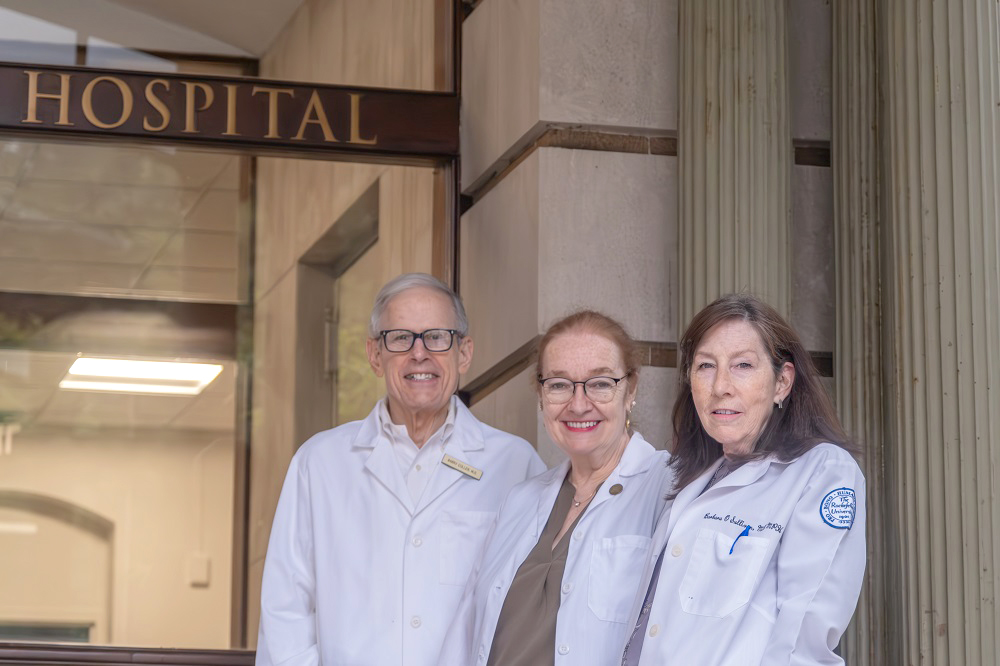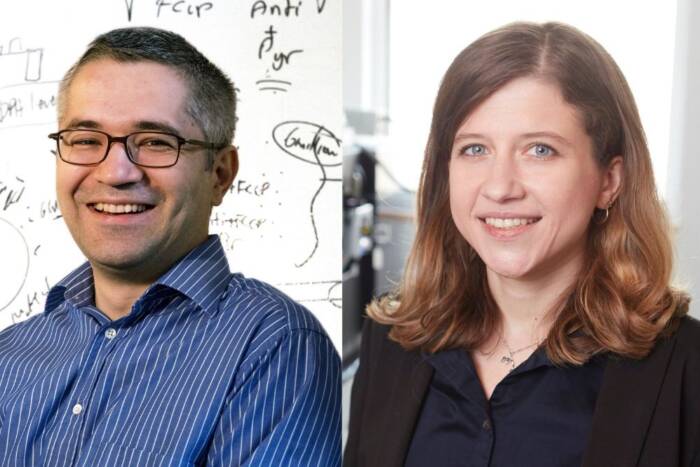How Rockefeller University Hospital became a leading facility for neuroscience research

RUH’s Barry Coller, Rita Devine, and Barbara O’Sullivan
One of the primary jobs of a nurse is to communicate with patients in their care. That becomes a complex, if not seemingly impossible, task when the patient is unconscious for an extended period of time, as is often the case following a severe brain injury. Can they hear a nurse’s voice? Sense the shifting of a pillow? Feel relief at the administering of medicine?
We’d know more about these patients’ ability to perceive and respond to the external world if scientists could study their brain activity over time in a controlled environment. But it’s difficult to create such a setting—one that combines skilled, compassionate nursing with scientifically rigorous research.
Nearly 20 years ago, Barry Coller, physician-in-chief of Rockefeller University Hospital (RUH), began planning how to create such an environment with renowned brain researchers Nicholas Schiff and Joseph Fins, of Weill Cornell Medicine’s Feil Family Brain and Mind Research Institute. After extensive modifications to RUH facilities and an intensive training of the nursing staff, by 2012 the hospital was ready to host an ambitious study of people with disorders of consciousness.
Since then, RUH has become one of the few facilities in the world that’s capable of simultaneously caring for minimally responsive patients and revealing what’s going on in their minds. It’s enabled groundbreaking neurobiology insights, recently published in the New England Journal of Medicine, that may shift the treatment of some of these patients from long-term maintenance to eventual recovery—and bring hope to their loved ones.
When it came to committing to such a comprehensive upgrade, “I felt that there was a profound medical and humanitarian need to help these patients and their families, as well as an equally important opportunity to advance our understanding of the underlying neurobiological mechanisms,” says Coller, who is also co-director of Rockefeller’s Center for Clinical and Translational Science. “We wanted to host important research that might ultimately have an impact on the lives of these individuals while also advancing scientific knowledge.”
There and aware
Many think of consciousness as a binary—one is either aware or unaware—but it’s more of a continuum of cognitive states. Disorders along this continuum include coma, vegetative state, locked-in syndrome, and minimal consciousness, in which people may be able to follow simple commands, speak coherently, or make intentional movements.
Their level of awareness has been difficult to quantify because many are unable to move. Some small studies have shown that the brains of 10–20% of people with these disorders are active, a condition called cognitive motor dissociation, regardless of how outwardly unresponsive they may seem. Those who have been diagnosed with cognitive motor dissociation recover better and faster.
Having this information can mean life or death for someone with a critical brain injury, because it can influence decisions about whether to continue or to withdraw life-sustaining treatment, how to care for a patient long-term, and expectations for recovery.
Custom renovations
In 2005, RUH began preparations to host the studies, based on Coller’s discussions with Schiff and Fins. Coller knew from the outset that this project would require the hospital to make a significant investment. But that wasn’t a barrier. “I knew wouldn’t be easy or quick, but I felt that we should commit the time, effort, and resources to make it happen,” he says. “Luckily, we have support from the university and the NIH Clinical and Translational Science Award program, which is especially important since we do not charge patients for their medical care or hospital stay.”
Seven years of planning and renovations ensued, all designed to make the facilities suitable for patients that require 24/7 care and a research agenda that required monitoring their brains 24/7.
The first step was to learn how to care for the patients, as that would inform the required infrastructure modifications. RUH nutritionists, pharmacists, hospital leaders, and the entire nursing team spent multiple days at long-term care facilities in the NYC metro area getting guidance from their medical directors and staff.
They had a lot to learn. “We weren’t used to that level of care for participants in clinical studies,” says Rita Devine, the director of nursing and patient care. “They need suctioning, turning, tube feeding, and bathing. We knew they were going to be totally dependent on us.”
As a result, they converted a large room in the hospital into a bathing unit that included a roll-in shower stall. They also made sure that there were twice as many private rooms as there were participants so that each could have a family member or professional caregiver stay overnight nearby throughout their three-day stay. Making caregivers comfortable was essential, Devine says. Many relatives have spent months or years attempting to convince doctors that their loved ones are not cognitively absent but people whose memories, thoughts, preferences, and even goals are intact.
“They are deeply protective,” Devine says.
They also have so much valuable information to share about each individual patient. That’s why the nurses reached out to them weeks before each patient’s arrival to glean key details—whether they liked the window shades up or down, for example, had a tender hip that needed to be shifted gently, or could communicate by blinking an eye or bending a finger.
The next step was to ensure that every patient room had the space and wiring for remote video and EEG monitoring equipment. This was the key reason the patients had to be brought into the hospital for the study: Such observations can’t take place in either acute-care settings or private homes, because the signals from other electrical devices in those spaces would create a cacophony of interference in the data.
To that end, Barbara O’Sullivan, RUH’s medical director, worked closely with the university’s IT team to wire each patient’s room for the video and EEG feeds, which were transmitted to a newly constructed operations center where researchers and nurses could observe them from one location. “This way the patient could be continuously monitored from a remote location without disturbing them,” O’Sullivan says. “The monitoring needs to be uninterrupted for the researchers to really get a sense of what’s going on in their brains.”
The renovations at RUH made it unique among the six facilities in the study, says Schiff. “It provided research facilities for both screening study patients and supporting in-patient, multiday studies, and it was also the only location capable of recording brain activity day in and day out using clinical-grade video and EEG monitoring in a controlled research environment,” he notes. “That allowed us to accumulate over 4,000 hours of data.”
Transformations over time
From 2012 to 2019, about 60 people with a disorder of consciousness participated in the study at RUH. A good number were young and had suffered a traumatic brain injury from a vehicle crash or while playing sports, and had their brains scanned at the hospital multiple times over the years, especially as their level of consciousness changed.
To meet the challenge, the hospital doubled up on the number of nurses and sometimes lengthened shifts to 10 or 12 hours. “But nobody minded. It’s very rewarding to take care of these people,” Devine says.
In all, the study assessed 353 participants at six facilities in four countries, asking them to complete both physical and mental tasks. Some questions were tailored to the individual’s personal history: a former tennis player might be asked to imagine swinging a racket, while a former swimmer might be prompted to envision being in a lap pool. Other tasks included identifying voices or sounds.
Through EEG and fMRI scans of the participants’ brains, the researchers showed that about a quarter of those who showed no outward sign of responding to commands had brain activity at the appropriate time, indicating they were doing the task in their minds.
“That tells you that many people who show no sign of consciousness at the bedside are actually aware,” Schiff says. “These people really are in there. There’s no ethical reason why they shouldn’t receive care that aims to help them recover.”
“This better understanding of the underlying neurobiology of these conditions is crucial to developing novel ways of helping the patients regain as much function and communication as possible,” adds Coller.
In addition to continuing their collaboration with the Weill Cornell team, the hospital is also eager to host other cutting-edge projects. “We have a clinical research facility in place that’s dedicated to neuroscience and the staff trained to care for even the most vulnerable of patients,” O’Sullivan says. “Every study is unique and requires customization, of course, but now we have the infrastructure to host translational brain research that is truly at the frontier of scientific innovation.”


